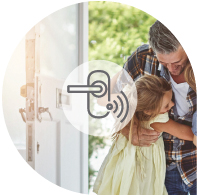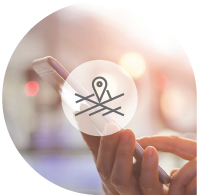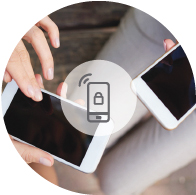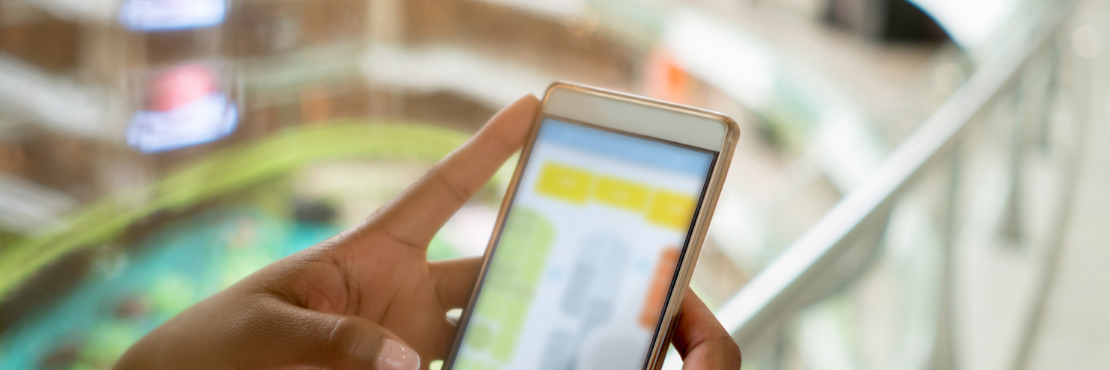Core UWB Services
Do you wonder how each of these experiences are made possible? All leverage the unique fine-ranging capability of UWB. If we stay at the user level, all use cases essentially rely on three core services:
 HANDS-FREE ACCESS CONTROL
HANDS-FREE ACCESS CONTROL LOCATION-BASED SERVICES
LOCATION-BASED SERVICES DEVICE-TO-DEVICE SERVICES
DEVICE-TO-DEVICE SERVICESHands-Free Access Control
Today’s secure access technologies typically have you perform an action – enter a code on a keypad, place a finger on a scanner, tap a badge or wristband on a reader – to open a doorway and enter a secured area, like your home or garage. With a UWB setup, you simply approach the door and it opens, leave the door on the unsecure (outside) and it locks. The UWB-based solution tracks your approach, verifies your security credentials, and lets you pass without having to stop and tap first. It’s basically Science Fiction made real, with doors opening and closing as needed, for convenient yet secure entry and exit.
UWB for hands-free access is complete freedom of movement, without compromising security. The identification process happens in an instant, and the door only unlocks if the user and the credential are both present and heading towards the door from the “outside”, so people without proper identification and clearance don’t gain entry. To make the setup more efficient, and prevent needless opening and closing, operation can be configured with various parameters such as not opening if you turn away from the door before you reach a certain point or if you simply stand within a certain distance of the door. UWB technology knows if you’re approaching or leaving, and understands what side of a door you’re on, so the lock and unlock functions happen at the right times, in response to your movements and positioning.
Working securely in combination with other connectivity technologies, such as Bluetooth Low Energy (BLE) and Near Field Communication (NFC), UWB-driven access works in mobile phones, badges, and other wearables, and can even lock or unlock doors when the device is turned off or in sleep mode.
Learn more:
FiRa Webinar Hosted by the Security Industry Association:
Ultra-Wideband (UWB) Explained (and why it’s an exceptional connectivity experience) >> (This Webinar finished already)
FiRa Whitepaper Hosted by the Security Industry Association:
Applying Ultra-Wideband Wireless Technology for Security and Automation >>
FiRa Consortium Technical Whitepaper:
Introduction to Impulse Radio UWB Seamless Access Systems >>
Location-Based Services
Satellite-based GPS services are a familiar technology when we’re traveling or spending time outdoors, but there are certain environments that make it hard to acquire or maintain a GPS signal, especially when we’re inside a building. UWB technology brings GPS-style positioning functionality, with a much higher degree of accuracy, to indoor environments. UWB offers highly precise positioning, even in crowded, multipath signal environments, and can pass through walls, machinery, and other obstacles. As a result, UWB makes it easier to navigate large spaces, such as airports and shopping malls, and makes it easier to find your car in a multi-story parking garage.
High-precision positioning also enables targeted digital marketing campaigns and foot traffic data. Following the guidelines that mobile-phone users specify for sharing their data, advertising displays can present a relevant mix of content based on who has approached the display. Retailers can present customized offers, government agencies can tailor their notifications, and entertainment venues can personalize recommendations during events.
Learn more:
FiRa Whitepaper Hosted by SecurityInformed.com:
Secure, Pinpoint Location with UWB-Enabled Indoor Positioning >>

Device-to-Device (Peer-to-Peer) Services
Thanks to Angle of Arrival (AoA) technology, two UWB devices can share relative ranging and positioning data to localize each other. That makes it possible for two people with mobile phones to locate each other with precision, parents don’t lose track of their children, and rideshare customers can find their driver in a sea of vehicles.
In smart homes, networked devices and appliances can respond to your presence automatically, as you enter a room. As soon as you enter a room (or even approach the entry), the lights can turn on, the thermostat can be set to your favorite temperature, and your preferred playlist can start streaming on the audio system. Technology is less intrusive, requires less oversight, and supports your everyday routine, while enabling a more energy-efficient and sustainable lifestyle.